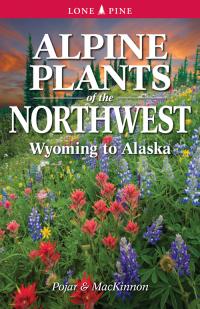
Jim Pojar and Andy MacKinnon became household names, at least among those households interested in native plants, with the publication in 1994 of “Plants of the Pacific Northwest Coast”. It has been the most popular field guide in the Miller Library ever since its introduction because of its clarity, organization, plant keys, and many features that give it added value.
Now, the two British Columbia authors/editors have matched their earlier work with a new title, “Alpine Plants of the Northwest”. While the previous work was a comprehensive study of all plants west of the Cascades, this book extends to the alpine and subalpine areas from the coast east to the Rockies, including north to the Yukon and Alaska. This is a large region, but as the number of plants that thrive above the timberline is limited it is a quite manageable guide, especially for those who hike in these areas. Like the earlier book, the Lone Pine publication has a soft but weather resistant cover, making it worth having at least one copy in your hiking party.
This model for field guides anywhere is a good blend of information for a broad range of competencies. Detailed keys required by the knowledgeable are nicely matched with photographs, drawings, and descriptions that will aid anyone in identification. Vexing, hard-to-distinguish species have additional aids, such as a conspectus with descriptive comparisons of both leaves and flowers of the many Potentilla, or leaf silhouettes of the members of the Carrot Family (Apiaceae).
But even if you are not a high country traveler, there is much to recommend in this book. The extensive introduction is much more than a how-to-use-this-guide as it provides an excellent background to the geology and climate (both historical and as changing) of the area of study, and the adaptations of the plant life. Throughout the body of plant descriptions are short sidebar essays to supplement the introduction.
Some of these are just for fun, such as the authors’ top ten favorite alpines, chosen by “flower size relative to the entire plant; appearance and colour; impact factor; plant chutzpah or elan.” What is number one? The Mountain Sapphire (Eritrichium nanum). Elsewhere, all five contributing authors describe their favorite alpine areas of the region.
This sense of fun is present throughout all the writing, but typically with a thoughtful point to make. “In past books, we’ve argued that scientific names are worth learning because they are generally more stable over time[…]it’s becoming more and more difficult to make that argument with a straight face.” This leads to a discussion of the changes brought often by genetic analysis in the plant genera and families. They conclude, “You can also learn scientific names to impress people”, with the tabloid quality tidbit that singer/model Carla Bruni married former French president Nicolas Sarkozy partly because “he knows all the Latin names” of plants!
Excerpted from the Fall 2013 Arboretum Bulletin.